Excerpts from Jim Conrad's
Naturalist Newsletter
from the October 23, 2016 Newsletter issued from Rancho Regenesis in the woods ±4kms west of Ek Balam Ruins; elevation ~40m (~130 ft), N20.876°, W88.170°; north-central Yucatán, MÉXICO
RED AMARANTH
Red Amaranth, AMARANTHUS CRUENTUS, is planted here and there at the rancho. Sometimes it's also called Blood Amaranth, Purple Amaranth, Prince's Feather, and Mexican Grain Amaranth. It's late in the season for Red Amaranth, so our plants are fully grown, but most of their leaves have withered away, and most of the flowering is past, so our plants look a little scraggly. Still, with their bright red color against the usual lush green backdrop, they're a conspicuous presence, as you can see below:
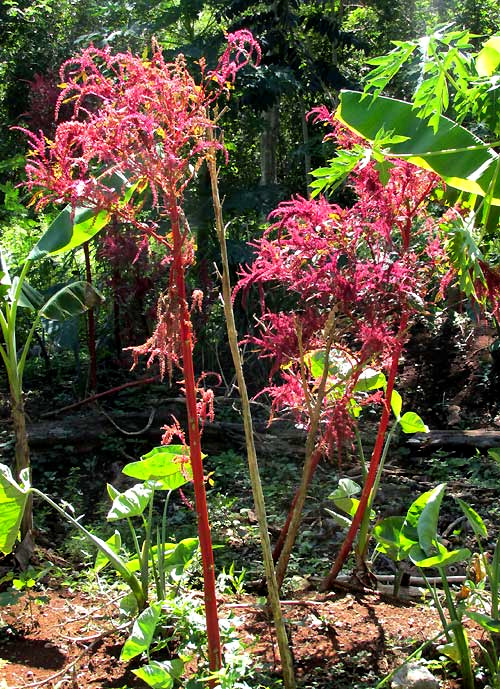
In the nearby village of Santa Rita, where I get the bicycle fixed, some folks grow Red Amaranth as ornamental bushes. There you can see that when they're regularly watered and cared for they can look impressive, as shown below:

A closer look at the colorful head of dense spikes and panicles, and its long-petioled, simple, smooth-margined leaves, is shown below:

Already the pistils of most flowers have matured into utricle-type fruits, a utricle being a bladdery, one-seeded fruit. Most of the bladders already have split open, releasing their single, tiny, shiny-black seeds, but if you look closely you can find seeds ready to fall from their open bladders. One is shown below -- that's the top of my thumbnail across the picture's bottom giving an idea how small the seed is:

Even this late in the season, if you shake a head over your open palm, several seeds fall out, as shown below:

Here at the rancho, fruiting heads of Red Amaranth are cut and hung upside-down in the chicken yard, so the hens can walk up and peck seeds out -- which they do with great relish. In fact, archaeological evidence shows that Red Amaranth was eaten by people in Mexico and Central America at least as far back as 6000 years ago -- both leaves and seeds being consumed.
Seeing how tiny the seeds are, you wonder that anyone would bother to eat them. However, the big flowering heads hold thousands of flowers, so at the peak of fruiting a good handful of seeds can be collected from each plant. Traditionally the seeds have been ground into flour, cooked into a kind of porridge, and popped like popcorn. Nowadays native people no longer gather the seeds, but the plant's leaves can be eaten like spinach. Also, the popped seeds now are used commercially to make the popular Mexican candy called alegría, an example of which is shown at www.backyardnature.net/m/food/alegria.jpg
Often the seeds are sold in health food stores, both for adding to dishes, and for sprouting. Amaranth seeds are present in generous amounts in my daily-eaten Mexican-made granola. Below, you can see a couple of black amaranth seeds sticking to a slice of banana in my breakfast bowl:
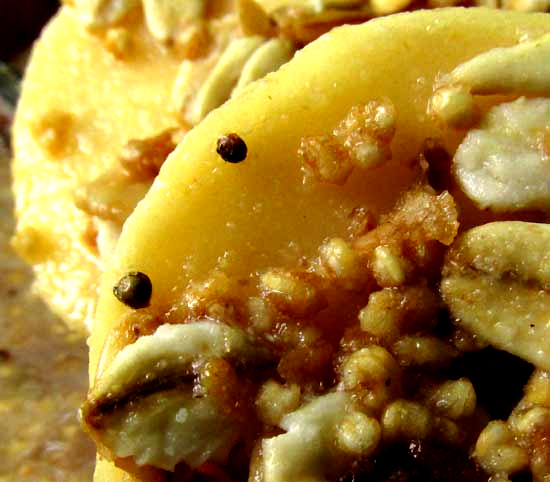
In the lower, right quarter of that picture, notice the many white items just a little larger than the black amaranth seeds. I think that those are popped amaranth seeds, or maybe that's how the black one look once they're cooked. I read that wild Red Amaranth seeds are black, while in the domesticated form they're white.
I've collected my own handful of seeds from the heads shown in these pictures, and have sown them in the garden, where I hope that later I can collect the leaves for cooking -- if the leafcutter ants permit.
from the September 14, 2007 Newsletter issued from Sierra Gorda Biosphere Reserer, Jalpan, Querétaro, MÉXICO
QUELITE/ AMARANTH
Across from a store where sometimes I buy my bananas there's a cornfield, a view into which you can see below:
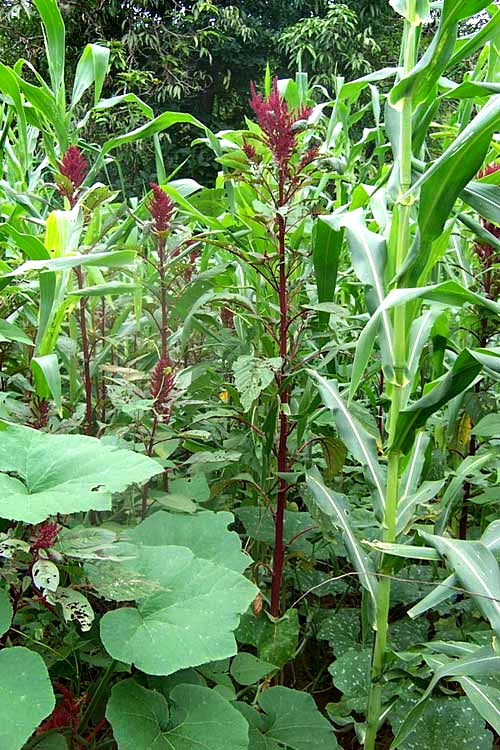
Notice that the corn is much taller than what is grown in fields up north. I held the camera about five feet above the ground and you can see how the corn towers above the lens. At the picture's lower left the large, roundish leaves belong to squash plants. If you look closely below the squash leaves you can see trifoliate blades of bean vines. The purplish plants among the corn stalks are AMARANTHUS CRUENTUS, often known in English as Prince's Feather, while people around here call it Quelite. Quelite is a general name used for several similar potherbs. Amaranthus is the amaranth genus.
Before the corn got so tall, when the Quelite was knee-high with a more compact inflorescence and with leaves more succulent and closer together, it was perfect for being picked and cooked just as northerners cook wild poke or turnip and spinach greens.
Thus Quelite is growing among the corn not as a weed but as part of a sophisticated, traditional food-growing system. Don't forget that the bean-vine's roots bear nodules with mycorrhiza, which produce nitrogen for the other plants. This shaggy-looking garden space is very efficiently providing four nutritious and tasty food items.
The other day I visited a hut in the mountains where the señora was busily stripping Quelite leaves from purple stalks her little boy had brought home, surely from a cornfield like this. Back on the farm in Kentucky we had Amaranthus hybridus -- thus a member of the same genus as Quilite -- growing weedily in our garden and around the barn, and it also could have provided us with nutritious greens. However, we called it Pigweed and would have laughed, if not felt insulted, if someone had suggested eating it.
from the December 18, 2016 Newsletter issued from Rancho Regenesis in the woods near Ek Balam Ruins north of Valladolid, Yucatán, MÉXICO
EATING AMARANTH LEAVES
Nowadays I surprise the Rancho's Maya workers not only by eating amaranth leaves, but also for the way I'm growing the plant. Below, you can see one corner of my Red Amaranth plant bed:

A close-up showing the leaves' pretty undersides is shown below:
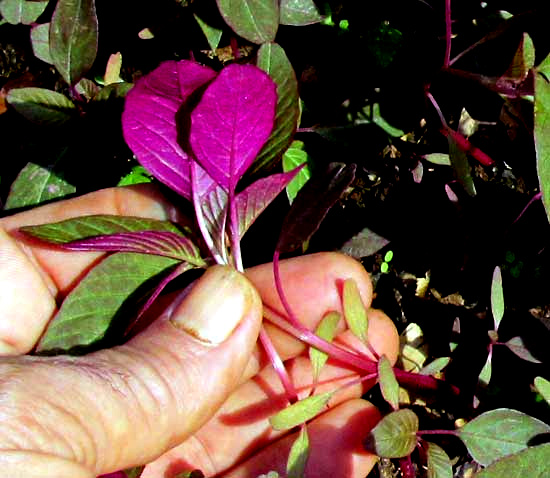
What the Maya find inexplicable is that I've sown the seeds so thickly. However, for years I've sown lettuce, mustard greens and turnip greens the same way. As soon as the crammed-together seedlings pop up, I begin harvesting and eating them -- thinning them out as I go. As the plants grow larger they find themselves separated from one another by ever greater spaces, yet always forming a dense but not-too-dense cover. Eventually the bed in our pictures will hold only half a dozen or so seven-ft-tall (2m) bushes, which will produce prodigious numbers of seeds.
On the InnovateUS.Net web page entitled "The 12 Health Benefits of Eating Amaranth Leaves" I read that amaranth leaves are "Packed with antioxidants, protein, vitamins, calcium, carbohydrates, iron and minerals..." with numerous health benefits. Amaranth leaves were part of the staple diet of the ancient Aztecs, Mayans and Incas.
Also at the NutritionData.Self.Com website, nutrition charts for amaranth leaves indicate that one cup of raw amaranth leaves (28g), supplies about the following in terms of a body's minimum daily requirement:
Vitamin K.......399%
Vitamin C....... 20%
Vitamin A....... 16%
Manganese....... 12%
The leaves are composed of 26% protein, which is amazingly high for a green leaf.
The NutritionData.Self.Com page's general review of raw amaranth leaves describes it as low in saturated fat, and "... a good source of Niacin, and a very good source of Protein, Vitamin A, Vitamin C, Vitamin K, Riboflavin, Vitamin B6, Folate, Calcium, Iron, Magnesium, Phosphorus, Potassium, Zinc, Copper and Manganese."
from the November 30, 2018 Newsletter issued from Rancho Regenesis near Ek Balam ruins in Yucatán, MÉXICO
HARVESTING & POPPING AMARANTH SEEDS
This week some Red Amaranth plants were dropping their seeds, so I collected enough to try my luck at popping them, and making a protein-rich gruel of the kind indigenous Americans used to make. Amaranth seeds are tiny, so you harvest them en masse. Below, you see the tiny, black, glistening seeds gathering atop my collecting platter -- an old wall-clock face retrieved from a trash dump:
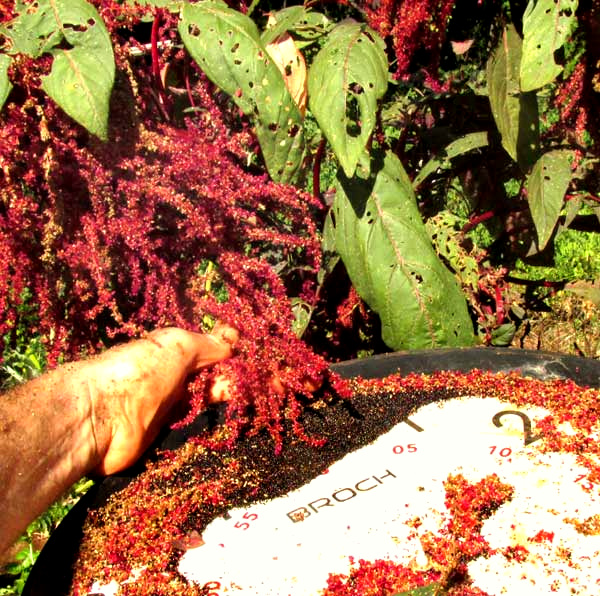
With one hand the platter is held beneath a flowering head while the other hand shakes the head, beginning at the top and squeezing-and-releasing as you work downward, a little like milking a cow. Many dried-out flower parts and all kinds of insects fall onto the platter along with the seeds. The insects leave mostly on their own, and the chaff can be blown off easily. You can't get every tiny piece of chaff, but there's nothing wrong with having some extra fiber in your porridge.
The seeds are hard, as if encased in thin plastic shells, so if you eat them as they are when they fall from the flowering head, the vast majority will pass right through your body providing little nutritional value. Ancient indigenous Americans learned to pop the seeds, exactly as we now pop popcorn. Half a cup of unpopped seeds produces about a cup of popped ones.
Unless you have a microwave, popping them isn't as easy or fast as popping popcorn. If they sit in oil a few seconds too long, the seedcoats rupture too early and they don't puff well, but if they sit there a few seconds too long after puffing, they cinderize. You get around that by heating your lightly oiled pan or skillet to the point at which a small sprinkle of seeds pop withing three or four seconds of when they're dropped inside. Add only about a tablespoon each time, pouring them out before they burn, and do it again.
I stirred about a cup of popped amaranth seeds into hot water and had my gruel. It was OK, like somewhat crunchy grits or mush, but I think you'd have to be pretty hungry or desperately need protein in your diet to regularly go to all the trouble of making amaranth-seed gruel. Of course, it might be a different story if you have a microwave.
If the infrastructure goes down, lots of people will be needing protein sources, calories from carbohydrates, antioxidants and the like, so it's a good idea to keep the amaranth-seed-eating possibility in mind. In the tropics amaranth is easy to grow, and harvesting can be expedited by growing large numbers of plants and collecting the seeds systematically. For example, large heads can be cut and hung to dry, with plastic sheeting below them for the seeds to fall on.
issued on December 1, 2019 from near Tepakán, north-central Yucatán state; elevation ~9m (~30 ft), N21.053°, W89.052°; MÉXICO
FLOWERING STUNTED PLANTS
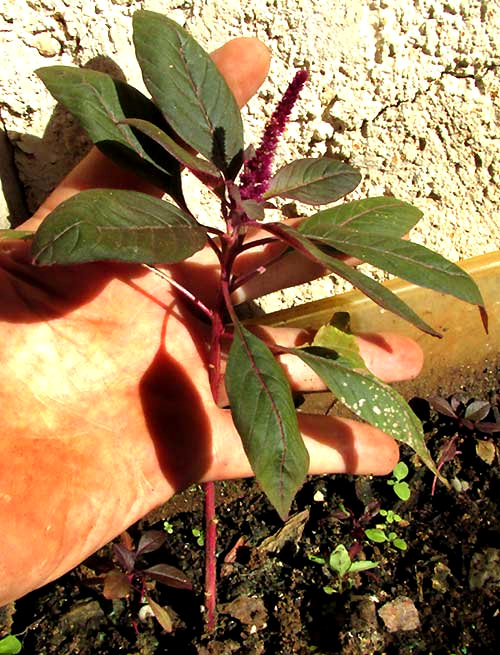
The above Red Amaranth plant, topped with a little spikelike flowering head, is worth thinking about. For, in our area cultivated Red Amaranths normally flower when they're at least 4ft tall (1.2m). I think our small plant is flowering because it needs daylight to last a certain amount of time, and since it germinated 5 or 6 weeks ago, the days have been too short, and getting shorter. I bet that if I'd waited until after the Winter Solstice, the plant would have grown to full size before flowering. In other words, certain plants require a certain PHOTOPERIOD in order to germinate and flower normally.
My guess about Red Amaranth's photoperiod is supported by the fact that last June I sowed plants -- that was late to sow them -- that now though only about knee high also are flowering. In a nearby weedy area where the soil was disturbed about six weeks ago, several much-smaller-than-usual weeds are flowering now, like my amaranth hustling to produce viable seeds because these shortening short days portend the dry season. Temperate Zone plants would be worrying about winter.
For gardeners in the Yucatan hoping to grow crops typical of the temperate zone, photoperiod is especially important, since, for example, now with November's cooler weather northerners might think it feels a little springy and thus good gardening weather. However, the days are getting shorter, as they will until the Winter Solstice on December 21st. Last year in October when the days were getting shorter I sowed cabbage for a test. The seeds germinated well, but then the plants just sat there, hardly growing at all, until the days started getting noticeably longer in January. By then, most plants were infected with various diseases and the stems were tough and knotty. If you want to know if a garden crop is "photoperiod sensitive," on the Internet you can search on such keywords as "cabbage photoperiod."
In the picture, also notice that -- unlike the last time I showed you my amaranth-green-growing box with its very crowded plants -- our little plant is nearly alone. When I sowed my seeds 5 or 6 weeks ago, I got a germination rate of only 5% or so, though I know the seeds were good. I read that Red Amaranth seeds are "relatively photoperiod neutral" in their germination, so something other than inappropriate photoperiod must have sabotaged my autumn amaranth crop.
I'm guessing that the poor germination was caused by ALLELOPATHIC compounds produced by my last amaranth crop (I'd used the same soil). Allelopathy is known for very many plants, who reduce competition for resources by retarding growth of surrounding plants, sometimes including its own offspring. So, here's another reason to avoid planting crops in the same soil where the species was recently sown.